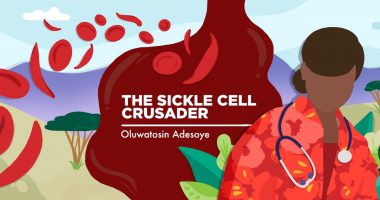Spreading awareness of sickle cell trait and its possible complications
A better understanding of the trait is crucial for both patients and providers

In discussions about sickle cell disease, the term “sickle cell trait” is often bandied about. But what does it mean?
Scientists have found that sickle cell trait originated as an evolutionary response to malaria, one of the deadliest illnesses in tropical regions. The trait offers natural protection against the infectious disease.
According to the U.S. Centers for Disease Control and Prevention (CDC), “Sickle cell trait is not a disease, but having it means that a person has inherited the sickle cell gene from one of his or her parents.” If a child inherits two sickle cell genes, one from each parent, then they will have sickle cell disease.
The CDC continues, “People with [sickle cell trait] usually do not have any of the symptoms of sickle cell disease and live a normal life.”
The key word here is “usually.” While the majority of patients with the trait don’t exhibit symptoms, it’s important to recognize that some do.
Symptomatic sickle cell trait
As the CDC explains, “in rare cases,” people with sickle cell trait may experience pain crises or other complications. These may be triggered by extreme conditions such as dehydration, physical trauma, or significant changes in oxygen levels, altitude, or atmospheric pressure.
At present, there’s no global consensus among researchers about why some people with sickle cell trait are symptomatic while most are not. More research is needed.
Complications
According to the American Society of Hematology, other complications associated with sickle cell trait include reduced blood supply to the spleen, glaucoma, muscle breakdown, and renal medullary carcinoma (RMC).
RMC is a rare and aggressive type of kidney cancer. As Pavlos Msaouel, a clinician and cancer biologist at the University of Texas MD Anderson Cancer Center, told the Patient Empowerment Network, “Having either sickle cell disease or sickle cell trait increases substantially the risk for developing RMC.”
This is because both groups have sickle-shaped red blood cells in the medulla, or the inner part of the kidney. While sickle cell disease patients have these misshapen cells throughout their body, those with sickle cell trait typically have normal red blood cells — except in the medulla.
“And to our understanding, having these cells that look like sickles in the medulla damages the medulla in a way that increases the risk for developing [RMC],” added Msaouel.
Unfortunately, RMC often isn’t detected early, as symptoms only appear in later stages of the disease. According to the National Organization for Rare Disorders, the average prognosis is 13 months after diagnosis, and that’s with treatment. Symptoms of RMC may include blood in the urine, flank pain, a mass in the abdomen, unintentional weight loss, and fevers. The disease is twice as likely to occur in men as in women.
Raising awareness of RMC is particularly important to me because a dear friend passed away from it a few years ago. Chad had sickle cell trait, and he experienced his first symptom, blood in his urine, on June 28, 2019. He fought to be taken seriously, but it took 11 doctor visits before a tumor was found on Aug. 29 of that year. In October, he received an official diagnosis of stage 4 RMC. Specialists used surgery and platinum-based chemotherapy to fight his cancer, but sadly, he passed away on Sept. 14, 2020. Chad is survived by his wife, who continues to share his story on Instagram, and two children.
What can we do?
As Msaouel noted, for every one person with sickle cell disease, there are an estimated 40 people with sickle cell trait — many of whom carry it unknowingly. It’s imperative that people get tested and know their sickle cell status.
In addition, it’s crucial that patients advocate for themselves if they’re experiencing symptoms, and that healthcare professionals take these concerns seriously. Because most people with sickle cell trait are asymptomatic, some providers mistakenly assume that this is the case for everyone. But even though complications are rare, they’re still possible. We can’t dismiss the trait as a nonissue.
It’s important to educate healthcare professionals about the reality of sickle cell trait so that patients experiencing issues can receive a quicker diagnosis and proper treatment. And by empowering those with the trait with knowledge, we can equip them to be vigilant and prepared.
Note: Sickle Cell Disease News is strictly a news and information website about the disease. It does not provide medical advice, diagnosis, or treatment. This content is not intended to be a substitute for professional medical advice, diagnosis, or treatment. Always seek the advice of your physician or other qualified health provider with any questions you may have regarding a medical condition. Never disregard professional medical advice or delay in seeking it because of something you have read on this website. The opinions expressed in this column are not those of Sickle Cell Disease News or its parent company, BioNews, and are intended to spark discussion about issues pertaining to sickle cell disease.








Comments